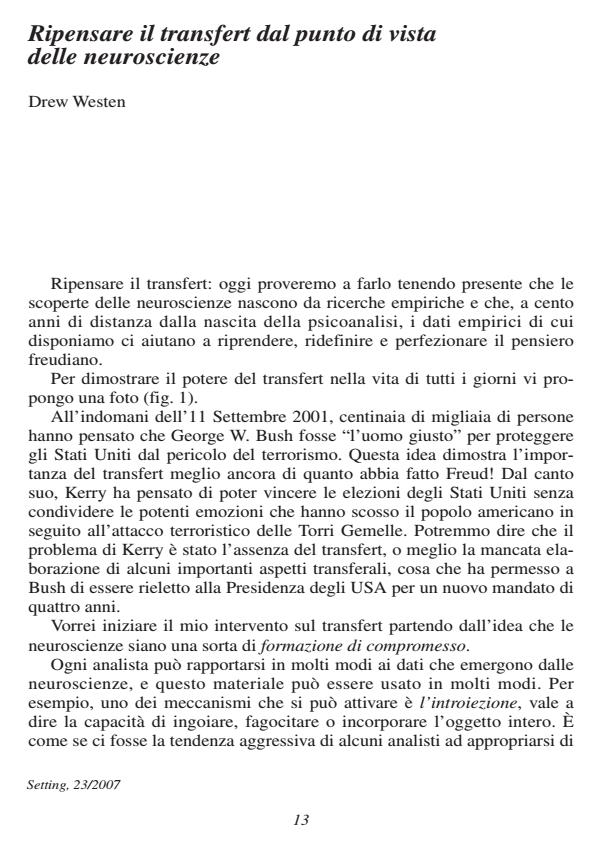Ripensare il transfert dal punto di vista delle neuroscienze
Titolo Rivista SETTING
Autori/Curatori Drew Westen
Anno di pubblicazione 2008 Fascicolo 2007/23
Lingua Italiano Numero pagine 24 P. 13-36 Dimensione file 502 KB
DOI
Il DOI è il codice a barre della proprietà intellettuale: per saperne di più
clicca qui
Qui sotto puoi vedere in anteprima la prima pagina di questo articolo.
Se questo articolo ti interessa, lo puoi acquistare (e scaricare in formato pdf) seguendo le facili indicazioni per acquistare il download credit. Acquista Download Credits per scaricare questo Articolo in formato PDF

FrancoAngeli è membro della Publishers International Linking Association, Inc (PILA)associazione indipendente e non profit per facilitare (attraverso i servizi tecnologici implementati da CrossRef.org) l’accesso degli studiosi ai contenuti digitali nelle pubblicazioni professionali e scientifiche
This paper, presented in June 2006 at the meeting Was Freud right? (1856- 2006), points out Drew Westen’s concept of the psychoanalytical transference as a set of patterns (thoughts, feelings, motivations, affective regulations and behaviours) emerging in the therapeutic relationship. It would reflect some definite features of the patient’s personality and interpersonal functioning more than the therapist’s ones. Why that kind of transference emerges in that just moment in that just treatment? Which the linking between past and now and here events? Westen’s answers root from the observation of brain processes by neuroimaging, that showed how thtransference in a definite phase of the analytical treatment reflects the confluence of neural associative networks activated in that phase and that two matching transference processes develop from them, the first leading to a cognitive activation of the past and the second to its edonic activation or inhibition. So, Westen can demonstrate his hypothesis of the transference as a form of compromise formation, cooperation or competition between cognitive and edonic activations. Every time the therapist refers to or thinks of her/his patient, the activation of these associative networks increases and lets the therapist understand even what the patient did not say verbally or explicitly. The article illustates also an interesting study about conflicts and defences of people standing for different political parties during the last (2004) presidential elections in the United States and its implications for the concept of transference as an activation of potentials based on the patient’s history and psychodynamics, Ripensare il transfert dal punto di vista delle neuroscienze shaped by the influence of the neural networks activated in a given time by various factors, among which the specific patterns of the therapeutic relationship and the therapist’s own characteristics.
Drew Westen, Ripensare il transfert dal punto di vista delle neuroscienze in "SETTING" 23/2007, pp 13-36, DOI: